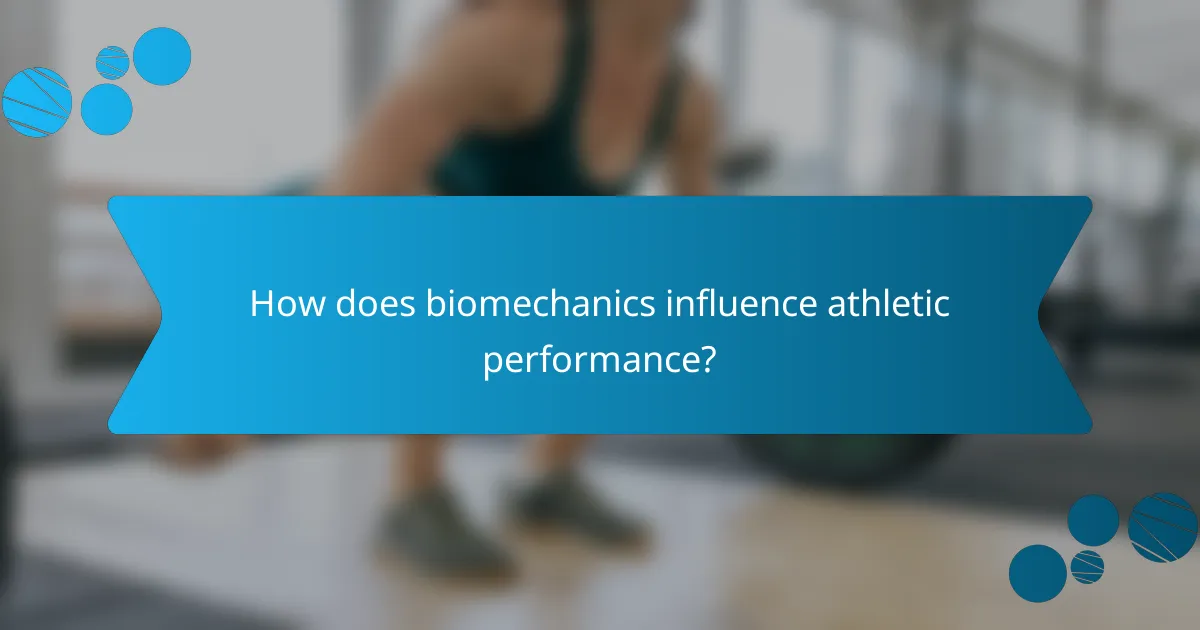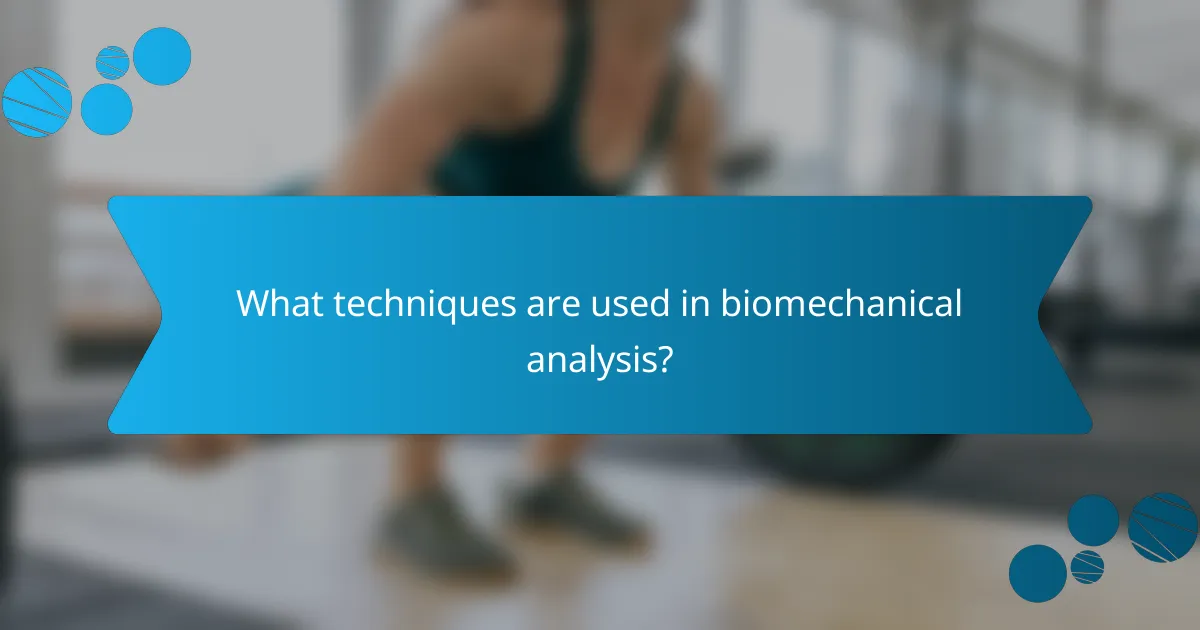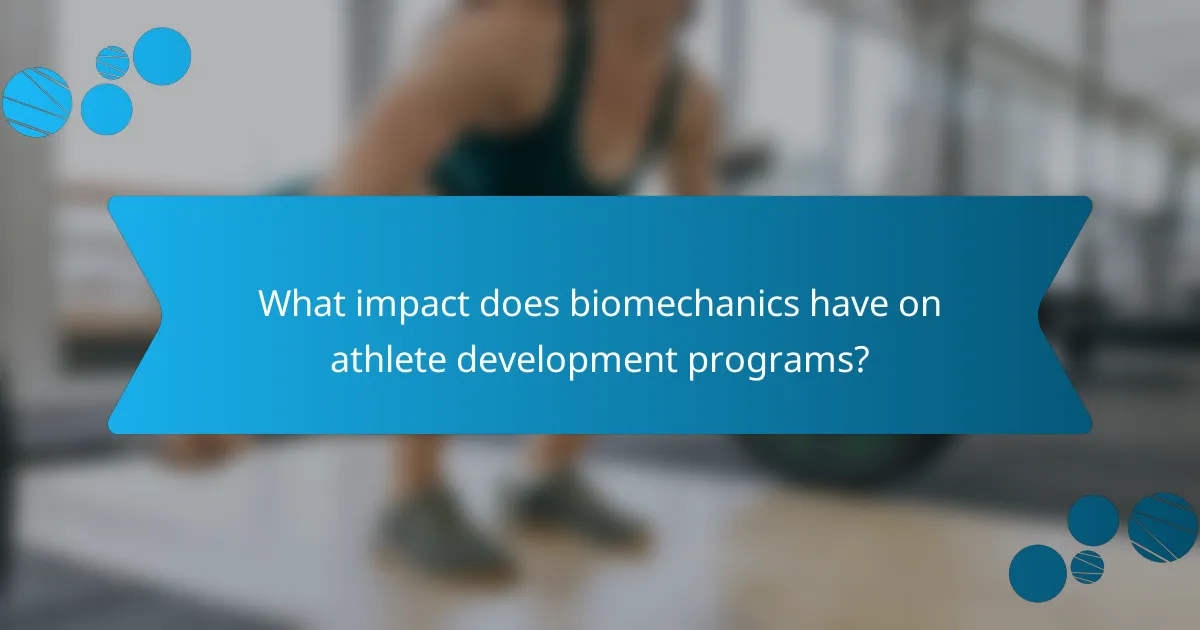Biomechanics enhances athletic performance by optimizing movement efficiency and minimizing injury risk. This article explores techniques like motion analysis and force measurement, applications in training and rehabilitation, and the impact on various sports disciplines. It also addresses challenges in implementing biomechanics effectively in athlete development programs.

How does biomechanics influence athletic performance?
Biomechanics significantly enhances athletic performance by optimizing movement efficiency and reducing injury risk. Techniques such as motion analysis and force measurement allow athletes to refine their skills. For example, analyzing a runner’s gait can lead to improved speed and endurance. Additionally, biomechanics informs training regimens that focus on strength and flexibility, tailoring programs to individual needs. This personalized approach maximizes performance outcomes and supports long-term athlete development.
What are the key principles of biomechanics in sports?
The key principles of biomechanics in sports focus on optimizing athletic performance and reducing injury risk. These principles include kinematics, which studies motion without considering forces, and kinetics, which examines the forces causing motion. Understanding these concepts allows coaches and athletes to analyze movement patterns effectively. Additionally, the principle of force application emphasizes the importance of technique in maximizing power and efficiency. By applying these biomechanical principles, athletes enhance their training and competitive strategies.
Which factors contribute to biomechanical efficiency in athletes?
Several factors contribute to biomechanical efficiency in athletes, including technique, strength, flexibility, and body composition. Optimal technique enhances movement patterns, reducing energy expenditure. Strength supports power generation, while flexibility improves range of motion. Body composition affects overall performance and energy efficiency.
How can biomechanics optimize training regimens?
Biomechanics can significantly optimize training regimens by enhancing movement efficiency and reducing injury risk. By analyzing athletes’ movements, coaches can tailor training to improve performance. Techniques like motion capture and force analysis provide insights into biomechanics, allowing for personalized adjustments.
For example, optimizing an athlete’s running form can lead to better speed and endurance. Additionally, understanding the biomechanics of strength training helps in selecting the right exercises that target specific muscle groups effectively.
The impact of biomechanics extends beyond performance; it fosters long-term athlete development by promoting sustainable training practices. Coaches leveraging biomechanics can create a more effective training environment that adapts to the athlete’s evolving needs.

What techniques are used in biomechanical analysis?
Biomechanical analysis employs techniques like motion capture, force plates, and electromyography. These methods assess movement patterns, quantify forces, and analyze muscle activation, enhancing athlete performance and injury prevention. Motion capture provides precise data on biomechanics, while force plates measure ground reaction forces during activities. Electromyography tracks muscle activity, offering insights into neuromuscular function. Together, these techniques contribute to a comprehensive understanding of athletic performance.
How do motion capture systems work in biomechanics?
Motion capture systems in biomechanics utilize sensors to track and analyze human movement. These systems capture data from reflective markers placed on an athlete’s body, translating physical motion into digital signals. The data is processed to evaluate biomechanics, providing insights into performance and injury prevention. Key attributes include real-time feedback, motion analysis accuracy, and applications in training optimization. Unique to these systems is their ability to simulate various athletic scenarios, enhancing athlete development.
What role do force plates play in performance assessment?
Force plates are crucial for assessing athletic performance by measuring ground reaction forces. They provide data on balance, stability, and power output during various movements. This information helps coaches tailor training programs to enhance performance and reduce injury risk. By analyzing metrics such as force production and timing, athletes can optimize their biomechanics for improved efficiency.
Which wearable technologies enhance biomechanical feedback?
Wearable technologies that enhance biomechanical feedback include smart shoes, motion sensors, and wearable exoskeletons. These devices provide real-time data on movement patterns, joint angles, and muscle activity. For example, smart shoes can measure gait dynamics, while motion sensors track body movements during athletic performance. Wearable exoskeletons assist in improving posture and reducing injury risk by providing biomechanical support. These technologies contribute significantly to athlete development by offering insights that inform training adjustments and rehabilitation strategies.

What are the applications of biomechanics in athlete rehabilitation?
Biomechanics plays a crucial role in athlete rehabilitation by enhancing recovery and performance. It applies principles of movement analysis to identify injury mechanisms and develop tailored rehabilitation programs.
Techniques such as motion capture and force analysis help assess an athlete’s biomechanics during recovery. These methods provide data on movement patterns, enabling coaches and therapists to create specific interventions. For example, optimizing running mechanics can reduce the risk of re-injury.
The impact of biomechanics on rehabilitation is significant. Improved understanding of joint angles and muscle activation patterns leads to more effective recovery strategies. This tailored approach not only accelerates healing but also enhances overall athletic performance post-rehabilitation.
How does biomechanics inform injury prevention strategies?
Biomechanics informs injury prevention strategies by analyzing movement patterns to identify risk factors. It helps in designing tailored training programs that enhance performance while minimizing injury risks. Techniques such as motion analysis and force measurement provide insights into how athletes can adjust their biomechanics for safer practices. For example, understanding the unique attributes of an athlete’s movement can lead to specific interventions that reduce the likelihood of injuries. As a result, biomechanics plays a crucial role in developing effective injury prevention protocols.
What rehabilitation techniques are grounded in biomechanical principles?
Rehabilitation techniques grounded in biomechanical principles include functional movement training, proprioceptive neuromuscular facilitation, and resistance training. These methods enhance biomechanical efficiency and injury recovery.
Functional movement training focuses on improving movement patterns, enhancing coordination, and reducing injury risk. Proprioceptive neuromuscular facilitation utilizes stretching and contraction techniques to enhance flexibility and muscle control. Resistance training builds strength and stability, supporting joint function and overall biomechanics.
Each technique is tailored to individual needs, addressing unique physical attributes and rehabilitation goals.
How can biomechanics aid in recovery timelines?
Biomechanics can significantly shorten recovery timelines by optimizing movement patterns and reducing injury risks. By analyzing an athlete’s biomechanics, specialists can identify inefficiencies and implement targeted interventions. These interventions may include tailored rehabilitation exercises, improved training regimens, and enhanced recovery strategies. As a result, athletes often experience faster healing and a return to peak performance levels.

How does biomechanics affect different sports disciplines?
Biomechanics significantly influences various sports disciplines by optimizing performance and reducing injury risk. Techniques such as motion analysis and strength assessment are applied to enhance athletes’ movements and strategies.
In sports like running, biomechanics helps refine gait patterns, improving efficiency and speed. In team sports, understanding body mechanics aids in developing better coordination and agility. For example, analyzing a basketball player’s shooting technique can lead to improved accuracy.
The impact of biomechanics extends to injury prevention. By studying force distribution and joint angles, coaches can adjust training regimens to minimize strain. This proactive approach is crucial in contact sports, where injuries are common.
Overall, biomechanics plays a vital role in athlete development, tailoring training techniques to individual needs and enhancing overall sports performance.
What unique biomechanical considerations are there for runners?
Runners face unique biomechanical considerations that impact performance and injury risk. Key factors include gait mechanics, foot strike patterns, and joint angles.
Gait mechanics influence how energy is transferred through the body during running. Variations in foot strike patterns, such as heel striking versus forefoot striking, affect shock absorption and propulsion. Joint angles, particularly at the knee and hip, determine stride efficiency and overall biomechanics.
Additionally, individual differences in anatomy, such as limb length and muscle strength, create unique attributes that can affect running style. These factors contribute to the risk of common injuries, including shin splints and runner’s knee, making personalized assessments crucial for athlete development.
How does biomechanics vary between team sports and individual sports?
Biomechanics varies significantly between team sports and individual sports. Team sports emphasize coordination and interaction among players, while individual sports focus on personal technique and performance optimization.
In team sports, biomechanics involves analyzing movements that facilitate teamwork, such as passing and positioning. For example, soccer players rely on biomechanics to enhance kicking techniques and sprinting efficiency during matches.
Conversely, individual sports require a deep understanding of personal biomechanics to refine skills like balance and agility. Athletes in sports like gymnastics or track and field often undergo biomechanical assessments to maximize their unique attributes, such as jump height or swing speed.
Overall, the application of biomechanics in athlete development is tailored to the demands and dynamics of each sport, influencing training methodologies and performance outcomes.
Which biomechanical factors are critical in contact sports?
Critical biomechanical factors in contact sports include force generation, body mechanics, and injury prevention strategies. These elements influence performance and safety. Proper alignment and technique enhance efficiency, while strength and conditioning support resilience against impacts. Understanding these factors aids in athlete development and optimizing training protocols.

What impact does biomechanics have on athlete development programs?
Biomechanics significantly enhances athlete development programs by optimizing performance and injury prevention. By analyzing movement patterns, coaches can tailor training regimens to individual athletes, improving technique and efficiency.
Key applications include gait analysis, strength assessments, and motion capture technology. These tools help identify biomechanical weaknesses and inform corrective strategies. For instance, a study found that incorporating biomechanics into training can reduce injury rates by up to 30%.
Moreover, biomechanics aids in developing sport-specific skills, allowing athletes to excel in their disciplines. This targeted approach fosters a deeper understanding of the physical demands placed on athletes, ultimately leading to improved outcomes in competitions.
Incorporating biomechanics into athlete development is essential for maximizing potential and ensuring long-term success in sports.
How can coaches integrate biomechanics into training plans?
Coaches can integrate biomechanics into training plans by applying movement analysis, enhancing technique, and optimizing performance. Utilizing tools like motion capture and force plates allows for precise assessments of athletes’ movements. This data helps in identifying inefficiencies and tailoring exercises to improve strength and flexibility. By focusing on biomechanics, coaches can develop personalized training regimens that address unique athlete needs, ultimately leading to improved performance and reduced injury risk.
What are the benefits of biomechanical assessments for young athletes?
Biomechanical assessments provide young athletes with enhanced performance insights and injury prevention strategies. These evaluations analyze movement patterns, identifying strengths and weaknesses. Improved biomechanics lead to optimized training regimens tailored to individual needs. Additionally, early detection of potential injuries can promote long-term athletic development.
Which organizations are leading in biomechanical research and athlete development?
Leading organizations in biomechanical research and athlete development include the American Society of Biomechanics, the National Institute for Sports Science, and the Australian Institute of Sport. These entities focus on enhancing athletic performance through advanced biomechanical techniques. They conduct research on movement analysis, injury prevention, and performance optimization. Collaborations with universities and sports teams further amplify their impact on athlete training programs.

What are the challenges in implementing biomechanics in training?
Implementing biomechanics in training presents challenges like equipment costs, technical expertise, and data interpretation. These hurdles can hinder effective application in athlete development.
First, high-quality biomechanics equipment often requires significant investment, limiting accessibility for many training programs. Second, specialized knowledge is essential; coaches and trainers must understand biomechanics principles to apply them effectively. Lastly, interpreting biomechanical data can be complex, making it difficult to translate findings into practical training adjustments.
How can athletes overcome biomechanical limitations?
Athletes can overcome biomechanical limitations through targeted training, technique adjustments, and equipment optimization. Implementing strength and flexibility exercises enhances performance. Analyzing movement patterns identifies inefficiencies. For example, using video analysis helps refine techniques, while specialized footwear can improve stability and reduce injury risk.
What are the common misconceptions about biomechanics in sports?
Common misconceptions about biomechanics in sports include the belief that it only focuses on injury prevention. In reality, biomechanics also enhances performance through technique optimization. Another misconception is that biomechanics is solely applicable to elite athletes; however, it benefits all levels of athletes by improving movement efficiency. Additionally, many think biomechanics requires complex technology, while basic principles can be applied with minimal equipment. Lastly, some believe that biomechanics is static, but it evolves with new research and technology, adapting to individual athlete needs.
Which resources are available for coaches to learn about biomechanics?
Coaches can access various resources to learn about biomechanics, including online courses, textbooks, and workshops. Notable online platforms like Coursera and edX offer specialized courses. Key textbooks such as “Biomechanics of Sport and Exercise” provide foundational knowledge. Additionally, attending workshops and conferences can enhance practical understanding and application.
What best practices should athletes follow to leverage biomechanics effectively?
Athletes should focus on proper technique, individualized training programs, and regular biomechanical assessments to leverage biomechanics effectively. These practices enhance performance and reduce injury risk.
1. Analyze movement patterns to identify inefficiencies.
2. Implement strength and conditioning tailored to biomechanical needs.
3. Utilize technology for real-time feedback on performance.
4. Regularly reassess biomechanics to adapt training strategies.